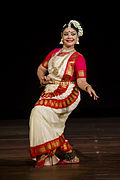| Revision as of 13:49, 16 October 2022 editFowler&fowler (talk | contribs)Autopatrolled, Extended confirmed users, File movers, Pending changes reviewers, Rollbackers63,218 edits →On branding me as someone who villifies Muslim and other accusations: ReplyTag: Reply← Previous edit | Revision as of 15:18, 16 October 2022 edit undoPacker&Tracker (talk | contribs)Extended confirmed users4,607 edits →On branding me as someone who villifies Muslim and other accusations: ReplyTag: ReplyNext edit → | ||
| Line 330: | Line 330: | ||
| :Please don't post this here. Thanks. ]] 13:38, 16 October 2022 (UTC) | :Please don't post this here. Thanks. ]] 13:38, 16 October 2022 (UTC) | ||
| ::You are using substandard sources, some of which are dated. You are also engaging in ]. A much bigger problem is that you are not able to write English clearly and articulately. I sincerely suggest that you cut your teeth on Start-class articles or stubs and take them to ]. The reviews and criticism there will surely help you to improve. Otherwise, you risk getting misunderstood and eventually penalized. I am attempting to give you friendly advice based on my experience on Misplaced Pages, not being paternalistic. Best regards, ]] 13:49, 16 October 2022 (UTC) | ::You are using substandard sources, some of which are dated. You are also engaging in ]. A much bigger problem is that you are not able to write English clearly and articulately. I sincerely suggest that you cut your teeth on Start-class articles or stubs and take them to ]. The reviews and criticism there will surely help you to improve. Otherwise, you risk getting misunderstood and eventually penalized. I am attempting to give you friendly advice based on my experience on Misplaced Pages, not being paternalistic. Best regards, ]] 13:49, 16 October 2022 (UTC) | ||
| :::Thanks for the kind advice; take some of my mine as well, the sources/scholars which disagree with your pov can not be buzzed off with lame reasoning of dated/sub standard etc. | |||
| :::1. The sources (cited above) most were your own high class tertiary sources apart from the ones I cited - (Chandra 2007) (Habib; ed Nizami 1981) & (David Thomas 2018) | |||
| :::2. It's quite ignorant to dismiss them as sub standard sources, the former two - Chandra and Habib are among the most respected scholars of Medieval India are in the same league as R. M. Eaton, Andre Wink, Hermann Kulke etc. The last one (Thomas; 2018) - has written several quality monographs on the Ghurids and has given his life researching on the dynasty. Any good historian surely knows that Md Ghuri's success was not due to his military capablities but clever diplomacy, he suffered three catastrophic defeats which potentially wouls have ended his life - Kayadhara 1178, Tarain 1191 and Andhkhud 1204 leaving aside his failure to subdue the Oghuzz as well which took him nearly 10 years after becaming the governor of Istiyan. | |||
| :::3. No, they are not archaic; Chandra and Thomas sources are from the 21st century (2007 & 2018 respectively) and Habib journal is still under 50 years and is detailed work on Md Ghuri's life. | |||
| :::4. I am actually quite benevolent in conceding an argument to end a dispute as is apparent from removal of K. S. Lal's quotebox, even when you removed the whole religion bit, I still didn't reverted you until today where you clearly went too far by introducing factual errors in the article. | |||
| :::5. No, Md. Ghuri did not took over the Khyber Pass in 1176, it took him some 20 years (round off) to capture it after his coronation in 1173. The shameful defeat he faced in Mount Abu - 1178 foiled all his plans of sweeping down the Gangetic plain, outflank the Ghaznawids from there and further to penetrate into the Peninsular India via Gujarat route like later Alauddin Khalji's and his lieutenants did as deep as Mariudri. It was around in 1190 when he actually captured the Khyber Pass before moving eastwards for the Gangetic doab. Nope !! I won't let you get your pov lead (removing debacle of Kayadhara) as the current one summarizes the body perfectly per ]. | |||
| :::6. Also, the maximum swathe of Ghurid expansion was not Herat to Gauda as you edited yesterday - they did expanded vastly (beyond Herat in west) after the death of Tekish and his son (Alauddin Khwarezm) and grandson (Hindu Khan) had a sucession struggle, the Ghurids did reached (briefly) till Gorgan (their maximum expansion) before Alauddin took over the throne around August 1200 (Ibn al-Athir states July and Minhaj states August) and regained his lost territories. (See ] for more details created by me) | |||
| :::7. Frankly, before arguing you actually need to properly learn about Md. Ghuri's life from detailed works on him and not some teritary works (If you are genuinely intersted in contributing to that article; first investiage primary works like I do before editing about a event, battle etc) - you don't know much about him apart from obvious details which any enthusiasts does. I improved on the gruesome factual errors in the article and expanded on its different aspect and not by adding original researches. | |||
| :::** Last but not the least - Be Civil !!! this is not tolerable now, you might get away this time as well but every day is not Sunday. (not me every editor that engages with you had the same issue not all are Hindu nationalists) Best regards. | |||
| :::'''PS:- Frankly, I am competent enough to edit more then start class article considering two of the articles I created about the subject were rated as B-Class immediately. I am tend to be quite busy in my real life and editing here is my secondary motive like all competent individuals and that's why sometime I post (only at t/p's in sketchy English); I had written academic journals in history to say the least and studied Indo-Persian chronicles for some 20 years now and can safely say that I am well-versed in them now. ] (]) 15:18, 16 October 2022 (UTC) | |||
| == ANI == | == ANI == | ||
Revision as of 15:18, 16 October 2022
| For the next several months I shall be working on only three articles, Mandell Creighton, Company rule in India, and History of English grammars. They have been on my back burner for far too long. I am already committed to finishing the India FAR. My time for all other activities on Misplaced Pages will be severely limited. Fowler&fowler«Talk» 21:55, 12 October 2022 (UTC) |
This user is aware of the designation of the following topics as contentious topics:
|
|
Archives |
|
1, 2, 3, 4, 5, 6, 7, 8, 9, 10 |
|
This page has archives. Sections older than 10 days may be automatically archived by Lowercase sigmabot III. |
Archive 22 Archive 23 Archive 24 Archive 25 Archive 26
India-related FPs I
-
 Indian vultures, (Gyps indicus), in a nest on the tower of the Chaturbhuj Temple, Orchha, Madhya Pradesh. The vulture became nearly extinct in India in the 1990s from having ingested the carrion of diclofenac-laced cattle.
Indian vultures, (Gyps indicus), in a nest on the tower of the Chaturbhuj Temple, Orchha, Madhya Pradesh. The vulture became nearly extinct in India in the 1990s from having ingested the carrion of diclofenac-laced cattle. 
-
 The bank myna is indigenous to the Indian subcontinent.
The bank myna is indigenous to the Indian subcontinent. 
-
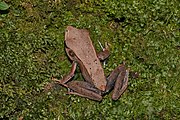 The vulnerable Malabar frog is endemic to the Western Ghats.
The vulnerable Malabar frog is endemic to the Western Ghats.
-
 The endangered Nilgiri tahr is endemic to the Western Ghats. Shown here is a female in a national park in Kerala.
The endangered Nilgiri tahr is endemic to the Western Ghats. Shown here is a female in a national park in Kerala. 
India-related FPs II
-
 The brahminy kite (Haliastur indus) hunts for fish and other prey near the coasts and around inland wetlands.
The brahminy kite (Haliastur indus) hunts for fish and other prey near the coasts and around inland wetlands. 
-
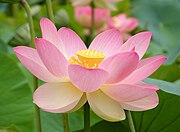 The lotus (Nelumbo nucifera) is the Indian national flower. Hindus and Buddhists regard it as a sacred symbol of enlightenment.
The lotus (Nelumbo nucifera) is the Indian national flower. Hindus and Buddhists regard it as a sacred symbol of enlightenment. 
-
 The Indian peafowl (Pavo cristatus) is the Indian national bird. It roosts in moist and dry-deciduous forests, cultivated areas, and village precincts.
The Indian peafowl (Pavo cristatus) is the Indian national bird. It roosts in moist and dry-deciduous forests, cultivated areas, and village precincts. 
-
 The Pahalgam valley in Jammu and Kashmir is covered with a temperate coniferous forest.
The Pahalgam valley in Jammu and Kashmir is covered with a temperate coniferous forest. 
India-related FPs III
-
A Toda tribal hut exemplifies Indian vernacular architecture.

-
 Bangles on display in Bangalore India
Bangles on display in Bangalore India 
-
 A Sadhu and a picture of Siva in Kayasth Tola, Varanasi, Uttar Pradesh in Northern India
A Sadhu and a picture of Siva in Kayasth Tola, Varanasi, Uttar Pradesh in Northern India 
-
 The pushkarani, or tank, located on the eastern side of Krishna temple in Hampi, Karnataka, the seat of the Vijayanagara Empire
The pushkarani, or tank, located on the eastern side of Krishna temple in Hampi, Karnataka, the seat of the Vijayanagara Empire 
India-related FPs IV
-
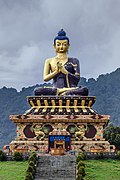 Large Gautama Buddha statue in Buddha Park of Ravangla, Sikkim
Large Gautama Buddha statue in Buddha Park of Ravangla, Sikkim 
-
 A Jain woman washes the feet of Bahubali Gomateswara at Shravanabelagola, Karnataka. The Bahubali idol is 18 metres (58 ft) high and is carved out of a single rock on top of a hill.
A Jain woman washes the feet of Bahubali Gomateswara at Shravanabelagola, Karnataka. The Bahubali idol is 18 metres (58 ft) high and is carved out of a single rock on top of a hill. 
-
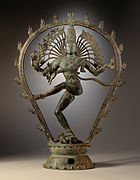 A Chola bronze depicting Nataraja, who is seen as a cosmic "Lord of the Dance" and representative of Shiva
A Chola bronze depicting Nataraja, who is seen as a cosmic "Lord of the Dance" and representative of Shiva 
-
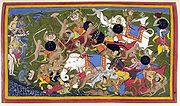 A sixteenth century rendering of a scene from the Ramayana, an ancient Sanskrit epic.
A sixteenth century rendering of a scene from the Ramayana, an ancient Sanskrit epic. 
India-related FPs V
-
 Paintings at the Ajanta Caves in Aurangabad, Maharashtra, 6th century
Paintings at the Ajanta Caves in Aurangabad, Maharashtra, 6th century 
-
 The Agasthiyamalai range, constituting the southern end of the Western Ghats, as seen from the rainshadow region of the southwest monsoon in Tirunelveli, Tamil Nadu.
The Agasthiyamalai range, constituting the southern end of the Western Ghats, as seen from the rainshadow region of the southwest monsoon in Tirunelveli, Tamil Nadu. 
-
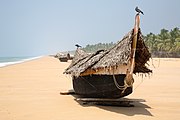 A beach off the Arabian Sea in Puvar, Kerala. The Arabian Sea is the northwestern region of the Indian Ocean, bounded by the Arabian and Indian peninsulas.
A beach off the Arabian Sea in Puvar, Kerala. The Arabian Sea is the northwestern region of the Indian Ocean, bounded by the Arabian and Indian peninsulas. 
-
Flowing through its rocky terrain near Hampi is the Tungabhadra river, the major right bank tributary of the Krishna river, a peninsular river, which empties into the Bay of Bengal. The coracles, made of wicker, are traditionally covered with hide, their circular shape preventing them from overturning in rivers with rocky outcrops.

India-related FPs VI
-
 The recycling industry in India, a Varanasi paper bag seller
The recycling industry in India, a Varanasi paper bag seller 
-
 An example of the Chinese fishing nets of Cochin. Fisheries in India is a major industry in its coastal states, employing over 14 million people. The annual catch doubled between 1990 and 2010.
An example of the Chinese fishing nets of Cochin. Fisheries in India is a major industry in its coastal states, employing over 14 million people. The annual catch doubled between 1990 and 2010. 
-
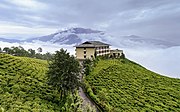 A tea garden in Sikkim. India, the world's second largest-producer of tea, is a nation of one billion tea drinkers, who consume 70% of India's tea output.
A tea garden in Sikkim. India, the world's second largest-producer of tea, is a nation of one billion tea drinkers, who consume 70% of India's tea output. 
-
A daily wage worker in a salt field. The average minimum wage of daily labourers is around Rs.100 per day

India-related FPs VII
-
 A bharatnatyam concert in 2014
A bharatnatyam concert in 2014 
-
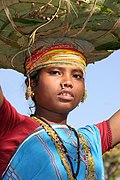 A Bondo woman walks to a weekly market in Chhattisgarh.
A Bondo woman walks to a weekly market in Chhattisgarh. 
-
A woman in Bundi, Rajasthan

-
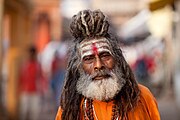 An ascetic in Varanasi, Uttar Pradesh
An ascetic in Varanasi, Uttar Pradesh 
India-related FPs VIII
-
 The tomb of Itmad Ud Daulah, Agra,
The tomb of Itmad Ud Daulah, Agra, 
-
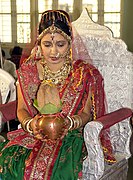 A Hindu bride
A Hindu bride 
-
 The interior of San Thome Basilica, Chennai, Tamil Nadu. Christianity is believed to have been introduced to India by the late 2nd century by Syriac-speaking Christians.
The interior of San Thome Basilica, Chennai, Tamil Nadu. Christianity is believed to have been introduced to India by the late 2nd century by Syriac-speaking Christians. 
-
 A Sikh pilgrim at the Harmandir Sahib, or Golden Temple, in Amritsar, Punjab
A Sikh pilgrim at the Harmandir Sahib, or Golden Temple, in Amritsar, Punjab 
India-related Classic Pictures-I
-
 A farmer in Rajasthan milks his cow. Milk is India's largest crop by economic value. Worldwide, as of 2011, India had the largest herds of buffalo and cattle, and was the largest producer of milk.
A farmer in Rajasthan milks his cow. Milk is India's largest crop by economic value. Worldwide, as of 2011, India had the largest herds of buffalo and cattle, and was the largest producer of milk.
-
 Indian agriculture dates from the period 7,000–6,000 BCE, employs two thirds of the national workforce, and is second in farm output worldwide. Above, a farmer works an ox-drawn plow in Kadmati, West Bengal.
Indian agriculture dates from the period 7,000–6,000 BCE, employs two thirds of the national workforce, and is second in farm output worldwide. Above, a farmer works an ox-drawn plow in Kadmati, West Bengal.
-
 Schoolchildren in Chambal, Madhya Pradesh eating a mid-day meal. The Mid-Day Meal Scheme attempts to lower rates of childhood malnutrition in India.
Schoolchildren in Chambal, Madhya Pradesh eating a mid-day meal. The Mid-Day Meal Scheme attempts to lower rates of childhood malnutrition in India.
-
 Cricket is the most popular game among India's masses. Shown here is an instance of street cricket.
Cricket is the most popular game among India's masses. Shown here is an instance of street cricket.
India-related FPs IX
-
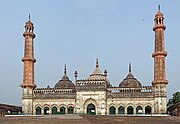 Asfi Masjid at the Bara Imambara complex, Lukcnow, India
Asfi Masjid at the Bara Imambara complex, Lukcnow, India 
-
 Chhota Imambara, Lucknow, India
Chhota Imambara, Lucknow, India 
-
 Taj Mahal mosque, Agra, India
Taj Mahal mosque, Agra, India 
-
 Bangalore panorama
Bangalore panorama 
India-related FPs X
-
 Red Weaver ant, Oecophylla smaragdina in Bangalore, India
Red Weaver ant, Oecophylla smaragdina in Bangalore, India 
-
 Female Telamonia dimidiata in the Lalbagh Botanical gardens, Bangalore, India
Female Telamonia dimidiata in the Lalbagh Botanical gardens, Bangalore, India 
-
 Mysore Palace in the morning
Mysore Palace in the morning 
-
 Indian Olympic athlete, Irfan Kolothum Thodi
Indian Olympic athlete, Irfan Kolothum Thodi 
India-related FPs XI
-
 Grammodes geometrica, Bangalore, India
Grammodes geometrica, Bangalore, India 
-
 Mumtaz Ahmed Khan founder of Al-Ameen Educational Society
Mumtaz Ahmed Khan founder of Al-Ameen Educational Society 
-
 Al-Ameen College of Pharmacy, Bangalore, India
Al-Ameen College of Pharmacy, Bangalore, India 
-
 Kumar Anish, Indian yoga specialist
Kumar Anish, Indian yoga specialist 
India-related FPs XII
-
 Taj Mahal at the golden hour
Taj Mahal at the golden hour 
-
 Bara Imambara, Lucknow, India
Bara Imambara, Lucknow, India 
-
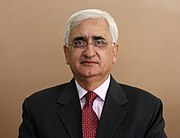 Salman Khurshid, Indian politician belonging to the Indian National Congress
Salman Khurshid, Indian politician belonging to the Indian National Congress 
-
 Indian palm squirrel, Bangalore, India
Indian palm squirrel, Bangalore, India 
India-related FPs XIII
India-related FPs XIV
-
Chandiroor Divakaran

-
 Karnataka High Court, Bangalore
Karnataka High Court, Bangalore 
-
 Dharmaraya Swamy Temple a Hindu temple in Bangalore
Dharmaraya Swamy Temple a Hindu temple in Bangalore 
-
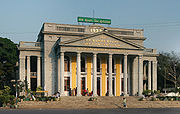 Bangalore Town Hall
Bangalore Town Hall 
Notice of No Original Research Noticeboard discussion
![]() There is currently a discussion at Misplaced Pages:No original research/Noticeboard regarding an issue with which you may have been involved. Thank you.
There is currently a discussion at Misplaced Pages:No original research/Noticeboard regarding an issue with which you may have been involved. Thank you.
October 2021
Buddha related FPs I
-
 Battered religious figures stand watch on a hill above a tattered valley. Nagasaki, Japan. September 24, 1945
Battered religious figures stand watch on a hill above a tattered valley. Nagasaki, Japan. September 24, 1945 
-
 17th century Painting on cloth of of Buddha Shakyamuni as Lord of the Munis with Bodhisatvas in background.
17th century Painting on cloth of of Buddha Shakyamuni as Lord of the Munis with Bodhisatvas in background. 
-
 The Gathering of Four Buddhas. 1562 CE, National Museum of Art, Korea.
The Gathering of Four Buddhas. 1562 CE, National Museum of Art, Korea. 
-
 Two women walk past the huge cavity where one of the ancient Buddhas of Bamiyan used to stand, June 17, 2012. The monumental statues were built in A.D. 507 and 554
Two women walk past the huge cavity where one of the ancient Buddhas of Bamiyan used to stand, June 17, 2012. The monumental statues were built in A.D. 507 and 554 
Buddha related FPs II
-
 Monk walks in the morning after the rain in front of the Temple of the Emerald Buddha (Wat Phra Kaew), part of the Grand Palace, Bangkok, Thailand.
Monk walks in the morning after the rain in front of the Temple of the Emerald Buddha (Wat Phra Kaew), part of the Grand Palace, Bangkok, Thailand. 
-
Buddha Amitabha in His Pure Land of Suvakti, Central Tibet. 18th century; Ground mineral pigment on cotton

-
 English: Shakyamuni Buddha with Avadana Legend Scenes. Tibet. Date 19th century
English: Shakyamuni Buddha with Avadana Legend Scenes. Tibet. Date 19th century 
-
 Chiang Mai, Thailand: Buddhist Manuscript Library and Museum
Chiang Mai, Thailand: Buddhist Manuscript Library and Museum 
Things to do on 6/10/22
- Start the article Singrauli estate (see Wikipedia_talk:Noticeboard_for_India-related_topics#Cleaning_up_confusions_about_"Singrauli_State"
- Start something on the Ethnic fermented foods and beverages of the Darjeeling Hills, using
- Thapa, Namrata; Tamang, Jyoti Prakash (2020), "Ethnic Fermented Foods and Beverages of Sikkim and Darjeeling Hills (Gorkhaland Territorial Administration)", in Tamang, Jyoti Prakash (ed.), Ethnic Fermented Foods and Beverages of India: Science History and Culture, Singapore: Springer Nature, ISBN 978-981-15-1485-2 and
- Tamang, Jyoti P.; Sarkar, Prabir K; Hesseltine, Clifford W (1988). "Traditional Fermented Foods and Beverages of Darjeeling". Journal of the Science of Food and Agriculture. 44 (4): 375–385. doi:10.1002/jsfa.2740440410.
- Add something on Tibetan refugees in Darjeeling.
The relevant news, June 24, 2022
Notice of edit warring noticeboard discussion
![]() Hello. This message is being sent to inform you that there is currently a discussion involving you at Misplaced Pages:Administrators' noticeboard/Edit warring regarding a possible violation of Misplaced Pages's policy on edit warring. Thank you.
Hello. This message is being sent to inform you that there is currently a discussion involving you at Misplaced Pages:Administrators' noticeboard/Edit warring regarding a possible violation of Misplaced Pages's policy on edit warring. Thank you.
Ghandi
Hey, I am sorry, but I removed no entire section on the Kheda campaign. Please check the revision history to confirm and then un-revert. Greetings, MeAmME (talk) 16:04, 2 October 2022 (UTC)
- Please be so kind to respond. Otherwise I'll have to assume that you don't care, and that I can revert your revert myself. MeAmME (talk) 07:42, 3 October 2022 (UTC)
- Apologies. I became distracted. Thanks for fixing it. Fowler&fowler«Talk» 11:10, 6 October 2022 (UTC)
We largely agree re: Buddha
But please remind yourself that grave dancing (or making pre-closing statements) is a bad look for most of us. Accept that your argument is well-made, the move is quite unlikely, and the RM unlikely to be repeated. BusterD (talk) 23:49, 5 October 2022 (UTC)
- Sorry if I'm acting like the dad. Probably like you, I'm more interested in an enduring outcome than a mere win. BusterD (talk) 23:51, 5 October 2022 (UTC)
- Thanks for the note. In retrospect, the grave dancing, a kind of facetiousness, was the sublimation of accumulated anger at page moves in general. If a title is grossly POV, fine, change it. But Misplaced Pages spends far too much time on dickering about which name is most easily comprehended by hoi polloi. Anyway, you're are correct. I've moved on to other things. Best regards, Fowler&fowler«Talk» 11:08, 6 October 2022 (UTC)
Attlee and decolonization
Hi - I wanted to ask about the undoing of the paragraph on Attlee and the decolonization decision. I had added that paragraph because I had not been able to easily find the point where Britain explicitly committed itself to self-rule, and the rationale for its commitment. I was wondering if we could restore some of what had been there earlier, particularly the distinction between Churchill's prior unenthusiastic conditional offers of Dominion status and Attlee's proposal of a relatively fast-moving Indian-led process that he set in motion immediately after his election in 1945. Most of the sources I've read see the September 1945 joint statement by Attlee and Wavell as the beginning of the process. I would like to include that information in a way that meets Misplaced Pages's standards, as I would find it useful to reference. Steve Negus (talk) 21:59, 9 October 2022 (UTC)
- @Steve Negus: Sorry, I couldn't find your post earlier because it was not arranged chronologically. But no big deal we have all made that error before. (You could click on "New Section" in the menu options above to make life simpler.) I am busy with some other stuff right now, but will examine what I did and why and reply here sometime tomorrow. Thanks. Fowler&fowler«Talk» 23:26, 11 October 2022 (UTC)
Assistance with the Chekavar page
Hello Fowler&fowler, I was wondering if you might have a bit of spare time to take a look at the Chekavar page. Since you've edited Indian caste-related pages in the past, not to mention the FA article India, do consider lending your views on it.
I had basically edited the lead paragraph on the Chekavar page to say that they were a warrior section within the Ezhava community, exactly as it states in the Ezhava lead paragraph. I used the same reference too. Then another user named @Lakbros changes it to say that they were a warrior caste, and he removes the hyperlink linking the Thiyyas with the Ezhavas, in order to establish the Chekavars as a separate warrior caste. The incident has been escalated to the ANI, as linked below:
https://en.wikipedia.org/Wikipedia:Administrators%27_noticeboard/Incidents#Caste_vandal
Any views on this would be greatly appreciated, thank you! TheWanderer9 (talk) 10:47, 13 October 2022 (UTC)
- Hello: Thanks for the post and for the confidence implicit in it. Unfortunately, for the next several months I shall be focusing on a small handful of topics only, as my user page and user talk page banners state. Another time, I would have most certainly helped out, but I am flat out of time. Best regards, Fowler&fowler«Talk» 10:57, 13 October 2022 (UTC)
October 2022
![]() Hello. I wanted to let you know that in your recent contributions to Muhammad of Ghor, you seemed to act as if you were the owner of the page. Everyone is welcome to contribute constructively to Misplaced Pages. This means that editors do not own articles, including ones they create, and should respect the work of their fellow contributors. If you create or edit an article, remember that others are free to change its content. Take a look at the welcome page to learn more about contributing to this encyclopedia. Thank you. ∆ P&t ♀√ (talk) 04:55, 16 October 2022 (UTC)
Hello. I wanted to let you know that in your recent contributions to Muhammad of Ghor, you seemed to act as if you were the owner of the page. Everyone is welcome to contribute constructively to Misplaced Pages. This means that editors do not own articles, including ones they create, and should respect the work of their fellow contributors. If you create or edit an article, remember that others are free to change its content. Take a look at the welcome page to learn more about contributing to this encyclopedia. Thank you. ∆ P&t ♀√ (talk) 04:55, 16 October 2022 (UTC)
- Neither do Hindu majoritarian POV pushers. Fowler&fowler«Talk» 05:00, 16 October 2022 (UTC)
- As expected from you another typical uncivil ranting. ∆ P&t ♀√ (talk) 05:05, 16 October 2022 (UTC)
- I'm not ranting. I'm not going to put up with nonsense in a vital article that is linked to the FA India. If you want to promote Rajput grandiosity on lesser-known pages be my guest, but not in the vital articles. I am going to bed now but will clean the lead tomorrow, just as I will the Delhi sultanate page. You are unable to read Farsi; had broken prose in the first paragraph, and no coherence either, which I had to fix. Fowler&fowler«Talk» 05:08, 16 October 2022 (UTC)
- You had suprisingly got several free passes despite of your uncivil tone, desregard for any source you don't settles with and as usual baseless accusations. Where did I promote so called Rajput grandiosity and villified Muslims ? You really need to behave in a better way, if not please keep on boasting about your FA India page.
- The lead simply mentions about his well-known defeats (Tarain and Kayadhara) apart from some other which Persian chroniclers omitted cleverly (Nizami and Aulfi even omitted the Tarain-1191 debacle); the very next line say he routed the Rajputs on the same battlefield.
- No, I do know Farsi; neither I touched upon the transliteration part either. I actually read the part (Minhaj and Nizami's original work about his gravesite) and then discovered this in the secondary source of Md. Habib.
- Enough of your uncivil and owning behaviour, see you on WP:ANI. ∆ P&t ♀√ (talk) 05:23, 16 October 2022 (UTC)
- (talk page stalker) I don't want to get into an extensive back-and-forth here, but may I respectfully remind both of you that a) the editor seeking inclusion of disputed content needs to establish consensus for it, and b) that consensus is best achieved via talk-page discussion of content specifics, not edit-warring? Save yourselves the trip to ANI, please. P&T, pointing an editor of 16 years tenure to Misplaced Pages's welcome page with a templated message is also quite rude. F&F, you could afford to be less brusque, if anyone is a Hindutva POV-pusher they need to be taken to AE, not have that tossed at them in talk-page discussions. Vanamonde (Talk) 05:37, 16 October 2022 (UTC)
- @Vanamonde93: Well, that warning regarding ownership of the article was actually meant to be in a polite tone that's why I used level-1 for it which has welcome template as well in it.
- I don't think any editor could get away with such behaviour as F&f had in the past, not only with me this is the case at several articles now - they brands everyone as Hindu Nationalists who don't concur with their pov, a recent example of there battleground mentality can be even seen at Akshay Kumar's article where veteran editors also pointed this out diff & diff.
- I am open to discussion regarding religion bit, although even that was kind of WP:OWN behaviour, if the editor post something relevant to the subject. (blatant misuse of WP:Tertiary policy by bringing source which barely mentions the subject, even disregarding them where they doesn't suits his/her pov is anything but collaborative behaviour.
- Could you also explain how I am a Hindutva pusher ?
- @Vanamonde93: Well, that warning regarding ownership of the article was actually meant to be in a polite tone that's why I used level-1 for it which has welcome template as well in it.
- (talk page stalker) I don't want to get into an extensive back-and-forth here, but may I respectfully remind both of you that a) the editor seeking inclusion of disputed content needs to establish consensus for it, and b) that consensus is best achieved via talk-page discussion of content specifics, not edit-warring? Save yourselves the trip to ANI, please. P&T, pointing an editor of 16 years tenure to Misplaced Pages's welcome page with a templated message is also quite rude. F&F, you could afford to be less brusque, if anyone is a Hindutva POV-pusher they need to be taken to AE, not have that tossed at them in talk-page discussions. Vanamonde (Talk) 05:37, 16 October 2022 (UTC)
- You had suprisingly got several free passes despite of your uncivil tone, desregard for any source you don't settles with and as usual baseless accusations. Where did I promote so called Rajput grandiosity and villified Muslims ? You really need to behave in a better way, if not please keep on boasting about your FA India page.
- I'm not ranting. I'm not going to put up with nonsense in a vital article that is linked to the FA India. If you want to promote Rajput grandiosity on lesser-known pages be my guest, but not in the vital articles. I am going to bed now but will clean the lead tomorrow, just as I will the Delhi sultanate page. You are unable to read Farsi; had broken prose in the first paragraph, and no coherence either, which I had to fix. Fowler&fowler«Talk» 05:08, 16 October 2022 (UTC)
- As expected from you another typical uncivil ranting. ∆ P&t ♀√ (talk) 05:05, 16 October 2022 (UTC)
I don't mind a trip at ANI and I am looking to post there as well ∆ P&t ♀√ (talk) 05:51, 16 October 2022 (UTC)
On branding me as someone who villifies Muslim and other accusations
Before posting this at ANI, let me answer a allegation against me by a friend and fellow editor Fowler&fowler, abusing me as a Hindu nationalist is bygone bit now, although it's still prevalent - (diff), now I am a castiest as well (for a caste which I don't even belongs to either) and also vilifies Muslims - (diff)
Leave everything aside, I never edited any article related to Muslims apart from historical articles (that too largely about Sansabanis and Md. Ghuri)
I am going to explain my part - from your own high class tertiary textbooks (those I have access to and are of really good quality) and from other left liberal scholars like Satish Chandra, IA Khan, Md. Habib and not from R.S.S. hitmans like late K. S. Lal.
→ Kulke, H.; Rothermund, D. (2004), A History of India, 4th, Routledge, ISBN 978-0-415-32920-0
1175 Muhammad of Ghur conquered Multan,
and in 1186 he vanquished Mahmud of Ghazni’s last successor, who had withdrawn to Lahore. Using the Panjab as a base for further conquest Muhammad of Ghur pursued his aim of annexing as much of India as he could. Unlike Mahmud of Ghazni he was determined to rule India and not just to plunder it. In 1178 he was not very successful in an encounter with the Chalukya ruler of Gujarat, but in 1191 and 1192 he waged two decisive battles of Tarain, to the northwest of Delhi, the region in which other famous battles of Indian history had been and were yet to be fought. The first battle of Tarain was won by the Rajput confederacy led by Prithviraj Chauhan of Delhi. But when Muhammad of Ghur returned the following year with 10,000 archers on horseback he vanquished Prithviraj and his army. After winning this decisive battle, Muhammad conquered almost the whole of northern India within a few years. In 1193 he defeated the mighty Gahadavala dynasty and captured Kanauj and Varanasi. Soon he also captured Gwalior, Ajmer and Anhilwara, at that time the capital of Gujarat. In this way most Rajput strongholds were eliminated. Many of these victories were due to the slave-general Qutb-ud-din Aibak, whom Muhammad then installed as his viceroy in Delhi. Eastern India, however, was conquered by another lucky upstart, Muhammad Bakhtiyar Khalji, who had risen to the rank of a general within a very short time. He captured Bihar, destroyed the University of Nalanda and, in about 1202, defeated King Lakshmana Sena of Bengal. This latter attack was so swift that it is said
that Lakshmana Sena was taking his lunch when it came. Bengal became a sub-centre of Islamic rule in India
(Kulke&Rothermund; 2004 pp:-167)
→ Ludden, D. (2014), India and South Asia: A Short History (2nd, revised ed.), Oneworld Publications, ISBN 978-1-85168-936-1
In 1190, he occupied Bhatinda, in Rajasthan, which triggered battles with the Rajput Prithviraja Chauhan, whom he finally defeated in 1192. Having broken the Rajput hold on western routes to the Ganga basin, the Ghurid armies marched east...
→ Gilbert, Marc Jason (2017). South Asia in World History. New Oxford World History series. Oxford and New York: Oxford University Press. ISBN 978-0-19-517653-7.
In 1192, one of Mahmud’s lieutenants and eventual successors, Muhammad of Ghur, defeated the chief opponent of the Muslim raiders, the Hindu Rajput Raja Prithvi Raj Chauhan, outside of his capital at Lolkat. By 1198, Turkic warriors had established their own capital there, which they named Delhi (“heart,” hence “capital”), and used it as a base to conquer most of the Indus Valley (which they called Hindustan) and the Gangetic Plain. From 1198 to 1240, conflict between Turkic clans over control of the sultanate commanded much of their attention
→ Robb, P. (2011), A History of India, Palgrave Macmillan, ISBN 978-0-230-34549-2
The third factor, invasions, became significant again from around 1000, when Punjab, Sind and the north Indian plain were once more attacked from the west, this time by the mobile Afghan armies of the Turk, Mahmud of Ghazni. He and his immediate successors
(after his death in 1030) established a Ghaznavid principality in the Punjab. It survived between 1021 and the arrival of the Ghurids in 1186; Muhammad of Ghuri was another Afghan Turk invader. He established a much wider control in north India. The Rajputs were unable to resist him, following his defeat in 1192 of Prithviraja III, king of the Chauhans, a Rajput clan based south-east of Delhi. Before his assassination in 1206, Muhammad set up a state relying upon both Turkish and Afghan nobles, a division that continued to plague his successors, Qutb-ud-din Aibak, of the so-called Slave Dynasty, and Iltutmish, the first of the Delhi sultans (r. 1211–36). Thereafter
a series of struggles between Afghans and Turks (a new element in Indian politics) was interposed with conquests and further invasions
(pp:-59)
→ Metcalf, Barbara D.; Metcalf, Thomas R. (2012), A Concise History of Modern India, Cambridge University Press, ISBN 978-1-107-02649-0
The Turks and Afghans, like invaders before them stretching back into millenia, originally entered the subcontinent through the mountain passage of the north-west. One immediate corrective to much scholarship is emphasize how much their kingdom had in common with other indic polities of the day. Like other states, including that of the celebrated Rajput Prithviraj Chauhan, the Turks and Afghans sought above all military successes in order to secure access to the agricultural surplus of the countryside
(pp:- 4)
- Well, apparently your main attempt (which I guess) was to remove his shambolic defeat in Battle of Kayadhara (appology for the screed) from the lead as can be seen here and just jump on subsequent expeditions against the Ghaznawids - diff with edit summary - Please don't edit war; you have a unreliable POV page here
- Just to let you know this (which you pushed for) was actually a unreliable addition apart from completely removing the rout of Mount Abu-1178 which even biased Persian accounts referred to Minhaj did (wrongly attributed it to Bhima II), so did Isami, Ferishta, Nizamuddin Ahmed (16th-17th century writers). No, he was not unsuccessful in dislodging Khusrau Malik in 1181 attempt - Khusrau Malik surrendered to him and send his son as a hostage before another raid (1184) where he sacked Lahore and the final blow was given in 1186. (See Siege part here) Md Ghuri being a third-rate general (and crooked dipolmat) is evident from the fact that to dislodge even a playful Khusrau Malik he still had accomplish it through through treachery.
→ Anyway; for Mount Abu-1178 rout:- Satish Chandra (2007). History of Medieval India:800–1700. Orient Longman. ISBN 978-81-250-3226-7. (a pre-eminent scholar of Meideval History of India; quite modern as well from 2007 for the basless Gomal and Kurram Pass argument which are barely different when approached to enter Rajasthan and the Gujarat belt anyway)
In 1173, Shahabuddin, Muhammad (1173–1206 (also known as Muizzuddin Muhammad bin Sam) ascended the throne at Ghazni, while his elder brother was ruling at Ghur. Proceeding by way of the Gomal pass, Muizzuddin Muhammad conquered Multan and Uchch. In 1178, he attempted to penetrate into Gujarat by marching across the Rajputana desert. But the Gujarat ruler completely routed him in a battle near Mount Abu, and Muizzuddin Muhammad was lucky in escaping alive. He now realised the necessity of creating a suitable base in the Punjab before venturing upon the conquest of India. Accordingly he launched a campaign against the Ghaznavid possessions in the Punjab. By 1190, Muizzuddin Muhammad had conquered Peshawar, Lahore and Sialkot,and was poised fora thrust towards Delhi and the Gangetic doab
(pp:-67)
→ Mohammad Habib (1981). K. A. Nizami (ed.). Politics and Society During the Early Medieval Period: Collected Works of Professor Mohammad Habib. People's Publishing House. (pp:- 111) (a specialised work on Md Ghuri's life)
Rai Bhim Deo of Gujarat collected his Rajput veterans and after a stiff battle, in which most of the invaders were slain drove Shihabuddun away from his kingdom
→ Here another one from David Thomas, a specialist on the Ghurids for Md Ghuri being a third-rate general and stiff native resistance David C. Thomas (2018). The Ebb and Flow of the Ghūrid Empire. Sydney University Press. ISBN 978-1-74332-542-1.
The frequency of Mu'izz al-Din dozen or more campaigns also indicates in part their lack of success in subduing the northern Indian Rajputs, untill victory in the second battle of Tara'in in 588 AH/1192 CE which opened the way to the conquest of northern India.
Note:-Habib possibly on basis of Minhaj writing attributed this victory to Bhima II (Mularaja's brother); though all epigraphic evidences strongly indicates that it was a stipling Mularaja II who give the invader such a defeat that atleast in his life again, he never turned towards Gujarat . (Aybeg sacked Anhilpura in 1197 not Md Ghuri)
Please don't make accusations that I defame the Muslim community, it's a request. ∆ P&t ♀√ (talk) 10:17, 16 October 2022 (UTC)
- Please don't post this here. Thanks. Fowler&fowler«Talk» 13:38, 16 October 2022 (UTC)
- You are using substandard sources, some of which are dated. You are also engaging in original research. A much bigger problem is that you are not able to write English clearly and articulately. I sincerely suggest that you cut your teeth on Start-class articles or stubs and take them to WP:DYK. The reviews and criticism there will surely help you to improve. Otherwise, you risk getting misunderstood and eventually penalized. I am attempting to give you friendly advice based on my experience on Misplaced Pages, not being paternalistic. Best regards, Fowler&fowler«Talk» 13:49, 16 October 2022 (UTC)
- Thanks for the kind advice; take some of my mine as well, the sources/scholars which disagree with your pov can not be buzzed off with lame reasoning of dated/sub standard etc.
- 1. The sources (cited above) most were your own high class tertiary sources apart from the ones I cited - (Chandra 2007) (Habib; ed Nizami 1981) & (David Thomas 2018)
- 2. It's quite ignorant to dismiss them as sub standard sources, the former two - Chandra and Habib are among the most respected scholars of Medieval India are in the same league as R. M. Eaton, Andre Wink, Hermann Kulke etc. The last one (Thomas; 2018) - has written several quality monographs on the Ghurids and has given his life researching on the dynasty. Any good historian surely knows that Md Ghuri's success was not due to his military capablities but clever diplomacy, he suffered three catastrophic defeats which potentially wouls have ended his life - Kayadhara 1178, Tarain 1191 and Andhkhud 1204 leaving aside his failure to subdue the Oghuzz as well which took him nearly 10 years after becaming the governor of Istiyan.
- 3. No, they are not archaic; Chandra and Thomas sources are from the 21st century (2007 & 2018 respectively) and Habib journal is still under 50 years and is detailed work on Md Ghuri's life.
- 4. I am actually quite benevolent in conceding an argument to end a dispute as is apparent from removal of K. S. Lal's quotebox, even when you removed the whole religion bit, I still didn't reverted you until today where you clearly went too far by introducing factual errors in the article.
- 5. No, Md. Ghuri did not took over the Khyber Pass in 1176, it took him some 20 years (round off) to capture it after his coronation in 1173. The shameful defeat he faced in Mount Abu - 1178 foiled all his plans of sweeping down the Gangetic plain, outflank the Ghaznawids from there and further to penetrate into the Peninsular India via Gujarat route like later Alauddin Khalji's and his lieutenants did as deep as Mariudri. It was around in 1190 when he actually captured the Khyber Pass before moving eastwards for the Gangetic doab. Nope !! I won't let you get your pov lead (removing debacle of Kayadhara) as the current one summarizes the body perfectly per WP:LEAD.
- 6. Also, the maximum swathe of Ghurid expansion was not Herat to Gauda as you edited yesterday - they did expanded vastly (beyond Herat in west) after the death of Tekish and his son (Alauddin Khwarezm) and grandson (Hindu Khan) had a sucession struggle, the Ghurids did reached (briefly) till Gorgan (their maximum expansion) before Alauddin took over the throne around August 1200 (Ibn al-Athir states July and Minhaj states August) and regained his lost territories. (See Battle of Andkhud for more details created by me)
- 7. Frankly, before arguing you actually need to properly learn about Md. Ghuri's life from detailed works on him and not some teritary works (If you are genuinely intersted in contributing to that article; first investiage primary works like I do before editing about a event, battle etc) - you don't know much about him apart from obvious details which any enthusiasts does. I improved on the gruesome factual errors in the article and expanded on its different aspect and not by adding original researches.
- Last but not the least - Be Civil !!! this is not tolerable now, you might get away this time as well but every day is not Sunday. (not me every editor that engages with you had the same issue not all are Hindu nationalists) Best regards.
- PS:- Frankly, I am competent enough to edit more then start class article considering two of the articles I created about the subject were rated as B-Class immediately. I am tend to be quite busy in my real life and editing here is my secondary motive like all competent individuals and that's why sometime I post (only at t/p's in sketchy English); I had written academic journals in history to say the least and studied Indo-Persian chronicles for some 20 years now and can safely say that I am well-versed in them now. ∆ P&t ♀√ (talk) 15:18, 16 October 2022 (UTC)
- You are using substandard sources, some of which are dated. You are also engaging in original research. A much bigger problem is that you are not able to write English clearly and articulately. I sincerely suggest that you cut your teeth on Start-class articles or stubs and take them to WP:DYK. The reviews and criticism there will surely help you to improve. Otherwise, you risk getting misunderstood and eventually penalized. I am attempting to give you friendly advice based on my experience on Misplaced Pages, not being paternalistic. Best regards, Fowler&fowler«Talk» 13:49, 16 October 2022 (UTC)
ANI
![]() There is currently a discussion at Misplaced Pages:Administrators' noticeboard/Incidents regarding an issue with which you may have been involved. Thank you. ∆ P&t ♀√ (talk) 09:57, 16 October 2022 (UTC)
There is currently a discussion at Misplaced Pages:Administrators' noticeboard/Incidents regarding an issue with which you may have been involved. Thank you. ∆ P&t ♀√ (talk) 09:57, 16 October 2022 (UTC)

